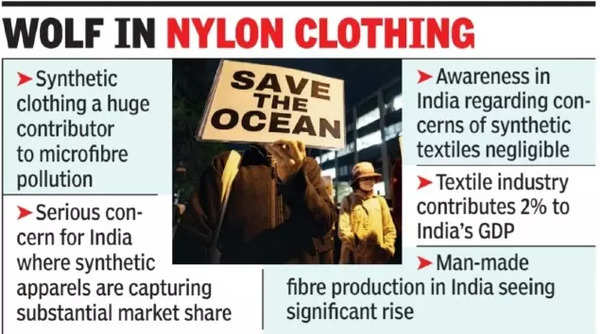- News
- City News
- nagpur News
- Nagpur: Synthetic clothes contribute 35% to global microplastics burden in oceans
Nagpur: Synthetic clothes contribute 35% to global microplastics burden in oceans

Representative purpose only
NAGPUR: Synthetic clothing is a huge contributor to microfibre pollution, especially in India, where synthetic apparel are capturing substantial market share. This was revealed in the first-of-its-kind research ‘Dirty Laundry: Threads of Pollution – Microfibres’ released on Thursday by environmental research organization Toxics Link.
Highlighting that 124 to 308 milligrams of microfibres are released per kilogram of fabric during washing, the study found that synthetic textiles add approximately 35% to the global release of primary microplastics to the world’s oceans. “Apparel made of synthetic materials like polyester, acrylic, nylon, and others consists of plastics and denote around 60% of the clothing material globally,” the study stated.

The study raises serious concern regarding microfibre pollution in India, which is the second-largest producer of polyester and viscose in the world. “The textile industry contributes 2% to India’s GDP and is one of the largest employment generators with over 45 million people under direct employment. Man-made fibre production in India has increased from 1,307 million kg in 2013-14 to 1,319 million kg in 2017-18,” the analysis stated.
Though globally there is greater awareness among consumers, researchers found that the awareness in India regarding the concerns of synthetic textiles is negligible.
In an earlier study done by Toxics Link, a high percentage of microfibre was found along the Ganges River in samples collected from Kanpur, Varanasi, and Haridwar. In another study by Toxics Link, water samples from Goa water treatment plant were found to have around 37 per cent of microfibre concentrations.
The latest study stressed on the impact of microfibre pollution on environment and human health due to its minuscule size and capacity to penetrate different ecosystems. “When ingested, these particles can induce chemical leaching in the body, disrupting the immune system and nervous system, causing congenital disabilities and tissue damage,” it added.
While globally technologies are being developed such as washing machine microfibre filters and microfibre capturing devices, there has been little effort in India in this direction. “Though PET bottles to yarn are touted as a great environment-friendly option, these plastic yarns also add to microfibre pollution. The washing machines we use at home do not contain any filtration system that can filter microfibres. Thus, microfibres can easily pass through it and through the drainage system to reach rivers and the oceans,” said Priti Banthia Mahesh, chief programme coordinator at Toxics Link.
The study also said that the country has no regulation or policy to check microfibre pollution caused by its mammoth textile industry. On the other hand, countries like France and the USA have mandated brands to mention the presence of synthetic material and how it will leach microfibre pollution. “It is imperative to bring together key stakeholders and institutionalise ways to curb plastic contamination across the textiles value chain. Sustainable, eco-friendly alternatives such as natural materials for clothing should be used, promoting nature-based entrepreneurship in the country,” said Satish Sinha, associate director at Toxics Link.
Highlighting that 124 to 308 milligrams of microfibres are released per kilogram of fabric during washing, the study found that synthetic textiles add approximately 35% to the global release of primary microplastics to the world’s oceans. “Apparel made of synthetic materials like polyester, acrylic, nylon, and others consists of plastics and denote around 60% of the clothing material globally,” the study stated.

The study raises serious concern regarding microfibre pollution in India, which is the second-largest producer of polyester and viscose in the world. “The textile industry contributes 2% to India’s GDP and is one of the largest employment generators with over 45 million people under direct employment. Man-made fibre production in India has increased from 1,307 million kg in 2013-14 to 1,319 million kg in 2017-18,” the analysis stated.
Though globally there is greater awareness among consumers, researchers found that the awareness in India regarding the concerns of synthetic textiles is negligible.
In an earlier study done by Toxics Link, a high percentage of microfibre was found along the Ganges River in samples collected from Kanpur, Varanasi, and Haridwar. In another study by Toxics Link, water samples from Goa water treatment plant were found to have around 37 per cent of microfibre concentrations.
The latest study stressed on the impact of microfibre pollution on environment and human health due to its minuscule size and capacity to penetrate different ecosystems. “When ingested, these particles can induce chemical leaching in the body, disrupting the immune system and nervous system, causing congenital disabilities and tissue damage,” it added.
While globally technologies are being developed such as washing machine microfibre filters and microfibre capturing devices, there has been little effort in India in this direction. “Though PET bottles to yarn are touted as a great environment-friendly option, these plastic yarns also add to microfibre pollution. The washing machines we use at home do not contain any filtration system that can filter microfibres. Thus, microfibres can easily pass through it and through the drainage system to reach rivers and the oceans,” said Priti Banthia Mahesh, chief programme coordinator at Toxics Link.
The study also said that the country has no regulation or policy to check microfibre pollution caused by its mammoth textile industry. On the other hand, countries like France and the USA have mandated brands to mention the presence of synthetic material and how it will leach microfibre pollution. “It is imperative to bring together key stakeholders and institutionalise ways to curb plastic contamination across the textiles value chain. Sustainable, eco-friendly alternatives such as natural materials for clothing should be used, promoting nature-based entrepreneurship in the country,” said Satish Sinha, associate director at Toxics Link.
FOLLOW US ON SOCIAL MEDIA
FacebookTwitterInstagramKOO APPYOUTUBE

Start a Conversation
end of article










